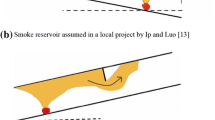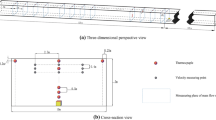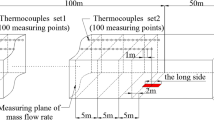Abstract
This paper has analyzed the asymmetric flow effect of fire-induced thermal flow in a horizontal tunnel under the natural ventilation condition by conducting large eddy simulations (LES). The key objective is to reveal and to have a better understanding of the asymmetric flow effect caused by the upstream and downstream tunnel length difference. The mechanism behind it can be explained based on the conservation of mass and dynamic force analysis on the smoke and fresh air. The strength of the asymmetric flow effect is characterized by the mass flow rate of the induced longitudinal flow (net mass flow rate of a cross-section). An empirical correlation to predict the induced longitudinal mass flow rate is proposed. Furthermore, the law of smoke and air flow distribution within a horizontal tunnel is established. The proportion of smoke (or air) flowing out (or coming in) through the opening increase (or decrease) linearly with the increasing distance between that opening to the fire location. The variation of the air flow with the longitudinal fire location in a tunnel is more sensitive than the smoke flow. Results have shown that as the fire approaches the tunnel exit from the middle of the tunnel, the smoke spilling out through this opening is reduced from 50% to 40%, while the fresh air incoming from this opening is increased from 50% to 100% and vice versa.
Similar content being viewed by others
References
Alarie Y (2002). Toxicity of fire smoke. Critical Reviews in Toxicology, 32: 259–289.
Bettis R, Eilersen U (2005). Fire Safe Design—Road Tunnels.
Cai N, Chow W-k (2014). Numerical studies on heat release rate in a room fire burning wood and liquid fuel. Building Simulation, 7: 511–524.
Carvel R (2019). A review of tunnel fire research from Edinburgh. Fire Safety Journal, 105: 300–306.
Chow WK, Li SS, Gao Y, Chow CL (2009). Numerical studies on atrium smoke movement and control with validation by field tests. Building and Environment, 44: 1150–1155.
Dahanayake KC, Yang Y, Wan Y, Han S, Chow CL (2020). Study on the fire growth in underground green corridors. Building Simulation, 13: 627–635.
Evans DD (1984). Calculating fire plume characteristics in a two-layer environment. Fire Technology, 20: 39–63.
Fan CG, Ji J, Sun JH (2015). Influence of longitudinal fire location on smoke characteristics under the tunnel ceiling. Fire and Materials, 39: 72–84.
Fan CG, Ji J, Li YZ, Ingason H, Sun JH (2017). Experimental study of sidewall effect on flame characteristics of heptane pool fires with different aspect ratios and orientations in a channel. Proceedings of the Combustion Institute, 36: 3121–3129.
Fan C, Zhang L, Jiao S, Yang Z, Li M, et al. (2018). Smoke spread characteristics inside a tunnel with natural ventilation under a strong environmental wind. Tunnelling and Underground Space Technology, 82: 99–110.
Heskestad G (1984). Engineering relations for fire plumes. Fire Safety Journal, 7: 25–32.
Hu LH, Huo R, Li YZ, Wang HB, Chow WK (2005). Full-scale burning tests on studying smoke temperature and velocity along a corridor. Tunnelling and Underground Space Technology, 20: 223–229.
Ingason H, Li YZ, Lönnermark A (2014). Tunnel Fire Dynamics. New York: Springer.
Ji J, Gao ZH, Fan CG, Sun JH (2013). Large Eddy Simulation of stack effect on natural smoke exhausting effect in urban road tunnel fires. International Journal of Heat and Mass Transfer, 66: 531–542.
Ji J, Guo F, Gao Z, Zhu J (2018). Effects of ambient pressure on transport characteristics of thermal-driven smoke flow in a tunnel. International Journal of Thermal Sciences, 125: 210–217.
Ji J, Tan T, Gao Z, Wan H, Zhu J, et al. (2019a). Numerical investigation on the influence of length-width ratio of fire source on the smoke movement and temperature distribution in tunnel fires. Fire Technology, 55: 963–979.
Ji J, Wang Z, Ding L, Yu L, Gao Z, Wan H (2019b). Effects of ambient pressure on smoke movement and temperature distribution in inclined tunnel fires. International Journal of Thermal Sciences, 145: 106006.
Karlsson B, Quintiere J (2002). Enclosure fire dynamics. Boca Raton, FL, USA: CRC Press.
Lee SR, Ryou HS (2005). An experimental study of the effect of the aspect ratio on the critical velocity in longitudinal ventilation tunnel fires. Journal of Fire Sciences, 23: 119–138.
Li YZ, Lei B, Ingason H (2011). The maximum temperature of buoyancy-driven smoke flow beneath the ceiling in tunnel fires. Fire Safety Journal, 46: 204–210.
Li YZ, Ingason H (2015). Fire-induced ceiling jet characteristics in tunnels under different ventilation conditions. Borås, Sweden: SP Technical Research Institute of Sweden.
Li YZ, Ingason H (2018). Overview of research on fire safety in underground road and railway tunnels. Tunnelling and Underground Space Technology, 81: 568–589.
Liu F, Yu L-X, Weng M-C, Lu X-L (2016). Study on longitudinal temperature distribution of fire-induced ceiling flow in tunnels with different sectional coefficients. Tunnelling and Underground Space Technology, 54: 49–60.
McGrattan KB, Baum HR, Rehm RG (1998). Large eddy simulations of smoke movement. Fire Safety Journal, 30: 161–178.
McGrattan K, McDermott R, Floyd J, Hostikka S, Forney G, Baum H (2012). Computational fluid dynamics modelling of fire. International Journal of Computational Fluid Dynamics, 26: 349–361.
McGrattan K, McDermott R, Hostikka S, Floyd J, Vanella M (2018). Fire dynamics simulator, technical reference guide, Volume 1: Mathematical Model. National Institute of Standards and Technology, Special Publication 1018–1.
Merci B, Beji T (2016). Fluid Mechanics Aspects of Fire and Smoke Dynamics in Enclosures. Boca Raton, FL, USA: CRC Press.
Motevalli V, Ricciuti C (1992). Characterization of the confined ceiling jet in the presence of an upper layer in transient and steady-state conditions. National Institute of Standards and Technology, Building and Fire Research.
Shi CL, Li YZ, Huo R, Yao B, Chow WK, et al. (2005). Mechanical smoke exhaust for small retail shop fires. International Journal of Thermal Sciences, 44: 477–490.
Tang F, Li LJ, Dong MS, Wang Q, Mei FZ, et al. (2017). Characterization of buoyant flow stratification behaviors by Richardson (Froude) number in a tunnel fire with complex combination of longitudinal ventilation and ceiling extraction. Applied Thermal Engineering, 110: 1021–1028.
Taylor G (1966). Oblique impact of a jet on a plane surface. Philosophical Transactions of the Royal Society of London A: Mathematical, Physical and Engineering Sciences, 260: 96–100.
Tsai K-C, Lee Y-P, Lee S-K (2011). Critical ventilation velocity for tunnel fires occurring near tunnel exits. Fire Safety Journal, 46: 556–557.
Wang Z, Zhu L, Guo X, Pan X, Zhou B, et al. (2019). Reduced-scale experimental and numerical study of fire in a hybrid ventilation system in a large underground subway depot with superstructures under fire scenario. Tunnelling and Underground Space Technology, 88: 98–112.
Wang Z, Ding L, Wan H, Ji J, Gao Z, et al. (2020). Numerical investigation on the effect of tunnel width and slope on ceiling gas temperature in inclined tunnels. International Journal of Thermal Sciences, 152: 106272.
Yan G, Wang M, Yu L, Duan R, **a P (2020). Effects of ambient pressure on smoke movement patterns in vertical shafts in tunnel fires with natural ventilation systems. Building Simulation, 13: 931–941.
Yang D, Huo R, Zhang XL, Zhao XY (2011). On the front velocity of buoyancy-driven transient ceiling jet in a horizontal corridor: Comparison of correlations with measurements. Applied Thermal Engineering, 31: 2992–2999.
Yao Y, Li YZ, Ingason H, Cheng X (2019). Numerical study on overall smoke control using naturally ventilated shafts during fires in a road tunnel. International Journal of Thermal Sciences, 140: 491–504.
Zhang Y, Li A, Hu J, Gao R (2014). Prediction of carbon monoxide concentration and optimization of the smoke exhaust system in a busbar corridor. Building Simulation, 7: 639–648.
Zhao S, Liu F, Wang F, Weng M (2018). Experimental studies on fire-induced temperature distribution below ceiling in a longitudinal ventilated metro tunnel. Tunnelling and Underground Space Technology, 72: 281–293.
Zukoski EE, Kubota T, Cetegen B (1981). Entrainment in fire plumes. Fire Safety Journal, 3: 107–121.
Acknowledgements
This work was supported by the National Natural Science Foundation of China (NSFC) under Grant No. 52006210 and No. 51722605, and the Key Research and Development Program of Anhui Province under Grant No. 201904a07020059. The computational resources used in this work were provided by the Supercomputing Environment of Chinese Academy of Sciences (ScGrid).
Author information
Authors and Affiliations
Corresponding author
Rights and permissions
About this article
Cite this article
Yu, L., Wan, H. & Ji, J. Asymmetric flow effect in a horizontal natural ventilated tunnel with different aspect ratios under the influence of longitudinal fire locations. Build. Simul. 14, 1311–1323 (2021). https://doi.org/10.1007/s12273-020-0742-y
Received:
Revised:
Accepted:
Published:
Issue Date:
DOI: https://doi.org/10.1007/s12273-020-0742-y




